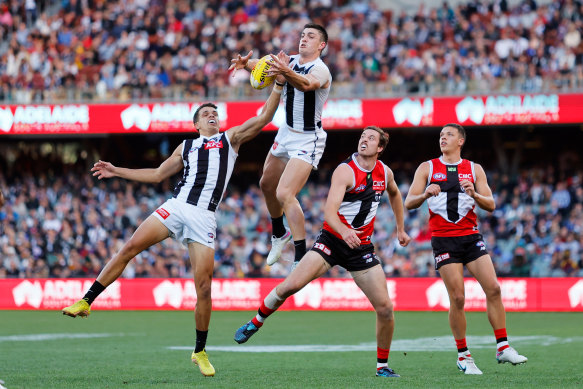This was published 1 year ago
Opinion
Bonanza or tipping point? AFL’s opening round tests fans’ stamina and patience
Peter Ryan
Sports reporterThere is no arguing the commercial logic behind “Opening Round” in which four matches will be played north of Victoria’s border to kick off the AFL season.
But that should not be the only consideration when assessing the idea that stretches the number of weekends in which AFL and AFLW games are played in this country to 39 (or 40 depending on when AFLW season starts in 2024).

The powerful Jordan De Goey was best on ground against the Giants in Collingwood’s preliminary final win and will be a key player in the opening round rematch. Credit: Getty Images
Opening round will turbocharge the game in the northern markets as it will allow government officials, corporate figures and sports fans in Brisbane and Sydney a weekend relatively free of the National Rugby League (NRL) to focus on Australian football.
The four clubs in non-traditional AFL markets have been arguing for such a boost via the fixture for years and with Andrew Dillon’s elevation to CEO they have been given a well-earned chance to launch the season.
Given the heavy lifting that quartet has engaged in for decades to grow the game beyond its traditional zones, they deserve the chance to kick with the wind.
Giants CEO Dave Matthews is full of praise for Dillon’s decision to give the two teams in Sydney “a marquee event at the right time of the year” and expects the match against Collingwood to be sold out.
Sydney CEO Tom Harley said it was “a smart decision from the code to launch the season north of the Murray”, with everyone interested in the AFL sure to be watching their Thursday night match against Melbourne.
Both Queensland clubs are also happy that the AFL has walked through the gap the NRL left in the second week of March when they decided to launch their season in Las Vegas on March 3 and scheduled games outside the capitals in round two. They didn’t have to be Nathan Cleary to find the gap, but they did act with conviction.
The AFL didn’t muck around with the match-ups either, with a repeat of last year’s preliminary finals and a triple premiership coach in Damien Hardwick up against his old team, the Tigers, on the Gold Coast, with six of last year’s eight finalists playing.
That is a positive that is impossible to deny in terms of the AFL’s objective to grow the game.
But there is a downside, and it needs to be pointed out to balance the marketing blitz the game embarks on when the fixture is released.
The AFL had already reached saturation point, but it now threatens to drown everything and everyone in a tsunami of football in 2024.
There will be just 95 days to breathe between the end of the AFLW season and the bounce of the ball in the middle of the SCG when Brodie Grundy fronts up to Max Gawn.
Between the opening round and the end of Anzac Day round on April 28, there will be an AFL game on 33 of 51 days, with a game on four of the seven weekdays for 15 weeks from March 7 until mid-June. That’s not to mention the circus which surrounds the AFL ramping up in February.
The appetite exists, but the AFL can’t pay lip service to the demands such a schedule puts on administrators and staff within the game, let alone the supporters.
No one seems to care too much about those working in the industry, but there will be an impact if the competition churns through people and their love for the game.
There are many reasons why AFLW crowds aren’t big and attention on it remains limited despite the competition’s standard improving, but one big factor is certain to be that many people just need a break from the game that dominates their winter.
The cricket season continues to be trampled on, with the Sheffield Shield midway through round 10 and the final round of many community cricket competitions in Victoria still under way when the AFL opens at the earliest date in its history, one day ahead of 2000 when the Sydney Olympics ensured that it started on March 8. That season finished on September 2.

The crowd at the 2000 grand final, which was played on September 2 to accommodate the Sydney Olympics.Credit: John French
Sporting seasons have been blurring for decades, but the AFL stretches the patience of their tribes at their peril, as well as the ground curators who have pitches and pre-season concerts to deal with on the eve of football seasons.
On a practical level, there is a better than even-money chance conditions will be hot in southern Queensland, with the temperature rarely dipping below 30 degrees there last March, and only last week the World Meteorological Organisation predicted El Nino will last until April 2024.
Carlton and Richmond might be keen for that early season bye, particularly after the Tigers have one less day to recover for their round one match.
Event status is craved in the sport and entertainment industries, and the AFL knows it needs to create something special to pack houses and build hype.

Collingwood’s Brayden Maynard flies for a mark at the Adelaide Oval on Sunday in the final game of last year’s Gather Round.Credit: Getty Images
But the demands on the supporters of big clubs such as Collingwood, Richmond and Carlton are growing as quickly as their membership bases who are being asked to dig deeper and deeper and deeper to watch their team live.
The AFL hopes holding opening round on a Labour Day long weekend – traditionally the final non-football weekend – will encourage Victorians to travel interstate for games.
They then hope they will travel a month later to watch them in Adelaide during the Gather Round, which was a wild success in 2023.
That is potentially too much to ask for many Victorian supporters who are attempting to navigate their way through a cost of living crisis.
For Carlton members building on the hype of last season they would need to follow their team to Brisbane on a Friday night, a Thursday night at the MCG during school term, a bye, the Good Friday match then over to Adelaide for a Saturday game to kick off the school holidays.
There is also a confusing element with round one being round two for some teams and round one for others and so on until each of the eight teams playing opening round complete their bye in the first six rounds.
If you are confused, try reading the ladder in that time, with Richmond and Carlton a chance to have won or lost two games before 10 teams have even kicked the footy.
Keep up to date with the best AFL coverage in the country. Sign up for the Real Footy newsletter.